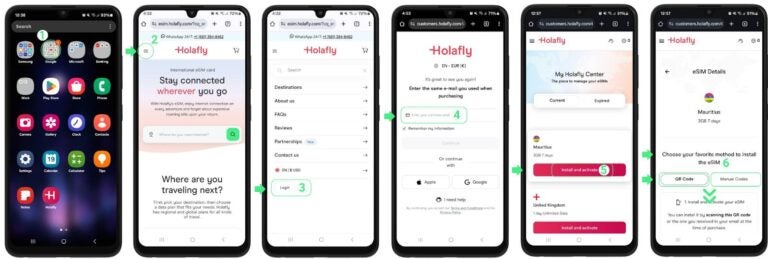Are eSIMs safe? Understanding security and risks
eSIMs are harder to hack, clone, and offer overall more security than a physical SIM card. Explore the main security measures that makes eSIMs safe to use.
Whether it’s the iPhone 16, Samsung Galaxy 25, or Pixel 9, modern smartphones have one thing in common: they are eSIM-only. This continued adoption of eSIM technology begs an additional question: are eSIMs safe to use?
We explore the main security advantages and risks of eSIM usage and how it differs from physical SIM cards. We’ll also compare both to see which is safer to use in 2025.
Is it safe to use an eSIM?
Yes, eSIMs are safe to use. In fact, they are more secure than physical SIM cards. They are harder to hack or clone and are safer to use for specific tasks, like banking or traveling.
Unlike traditional SIM cards, eSIMs can’t be installed on multiple devices. With a SIM card, you simply need to remove the SIM card, place it on another device, and that’s it.
Overall, it’s a safer technology, as it has comprehensive security measures which we’ll mention further down, unlike traditional SIM cards.
Is an eSIM safe for banking?
Yes, eSIMs are a safe option for banking. These are harder to clone and can be easily deleted from your phone, as requesting a new eSIM profile will deactivate the previous one.
Previously, if someone stole or accessed your phone and got access to your SIM card, they could authorize and approve transactions.
Can eSIMs get hacked?
While it’s not impossible for an eSIM to be hacked, as is the case with most digital products, the way an eSIM works makes it difficult for security breaches to occur.
Someone would need to access your device to find the eSIM details in order to hack your eSIM, but since it is activated with a QR code or manually, this is almost impossible.
Another feature is that eSIM profiles can be easily deleted or erased, even remotely. This means you can freeze or remove your eSIM through your service provider account or by contacting customer support, putting an end to potentially harmful activities.
Still, you need to keep an eye out for things like:
- Phishing attacks and social engineering tricks
- Malware found on websites and APKs
- Suspicious activities on social media apps
While monitoring what apps and websites you visit is the best way to stay protected, consider downloading an antivirus for an extra layer of security on your devices.
Is eSIM safe from SIM swapping?
SIM swapping is as possible from a SIM or eSIM card. The “trick” behind this is when a hacker tries to impersonate you and finds a way to access your service provider by providing a new eSIM profile or SIM card, leaving the previous ones useless.
Here’s an important point: The “success” of something like this depends on the authentication protocols and other security measures mobile network operators decide to use.
So when choosing which provider is the best for you, consider the following aspects to avoid issues:
- How do they protect my personal data?
- What identity theft protocols do they handle?
- How easily can some access sensitive data?
Can an eSIM be tracked?
Both eSIMs and SIM cards can be tracked. This is because mobile devices include an international mobile equipment identifier (IMEI), which helps service providers and authorities track devices when necessary.
The tracking doesn’t depend on whether you use a SIM card or an embedded SIM card. It will occur for as long as you’re connected to the internet, meaning your mobile network provider, authorities, and others can determine your location.
If you want to take security measures to avoid this tracking, you can always install a VPN and turn off the location services on your phone to get more user privacy.
Can an eSIM be cloned?
Cloning an eSIM is harder than cloning a traditional physical SIM card. On SIM cards, hackers need access to the card to clone it, but they can’t do that with an eSIM.
If you’re using an eSIM for your home carrier plan, it can’t be cloned remotely either because of how mobile network providers work. Most require you to access your account and request a new eSIM profile.
The same goes for travel eSIMs. If you think someone is trying to clone your eSIM, you can contact customer support and ask them to deactivate your previous eSIM profile and request a new one.
Lastly, when it comes to cloning, hackers must replicate the international mobile subscriber identifier (IMSI) and an encryption key mobile carriers request to identify their mobile lines, making it harder for an eSIM to go under any SIM swap attacks.
Are eSIMs safer than physical SIMs?
Yes. eSIMs are much safer than physical SIM cards. Mostly, this is down to the fact that a digital SIM is harder to find, clone, or steal.
eSIMs allow you to easily delete/erase your profiles from unauthorized devices and make it almost impossible for yours to be cloned; it has quite an advantage over SIM cards.
There are some areas that eSIMs can’t help, like tracking, as this security measure depends on your mobile network provider.
Overall, an eSIM makes things safer, and while you still need to act with caution when downloading APKs and visiting unknown sites, eSIMs add an extra layer of security to your personal and financial information.
Are travel eSIMs safe?
Knowing eSIMs are safe to use, these have rapidly become a go-to option for travelers, as you can connect to secure mobile networks and avoid relying on free WiFi connections.
One of the safest eSIMs is Holafly. With its 24/7 customer support and app, Holafly gives you the chance to manage eSIM profiles, find your eSIM details, and protect your internet connection at no extra cost.

The travel eSIM is available in over 200 destinations and offers unlimited mobile data plans with customizable days. You can choose anywhere from 1 to 90 days to get hassle-free connectivity abroad with pricing as low as $1.55/day.
Staying in a single destination for longer than a month? Or traveling to multiple places one after the other? Holafly Plans, a monthly subscription for global coverage, gives you peace of mind as you travel. Choose from unlimited data, 25 GB, or 10 GB plans that effortlessly roll over from one month to the next. Keep your connectivity details all in one place with a plan that follows wherever you go!
With Holafly, you’ll also avoid other travel issues, like international roaming fees or standing in line with your passport to pick up a physical SIM card.





 Language
Language 


















 No results found
No results found












